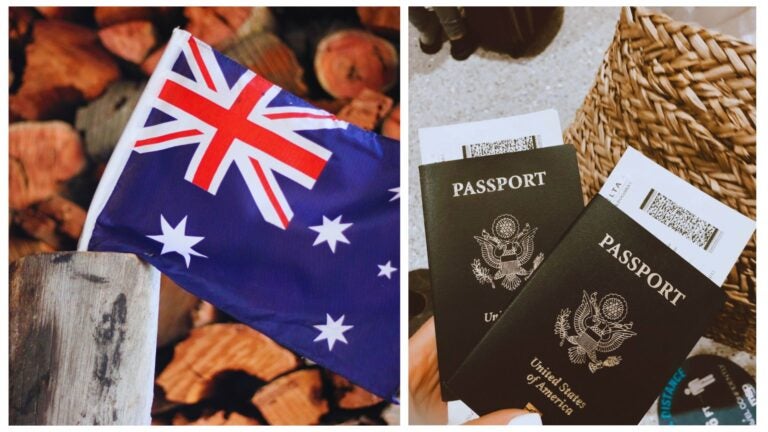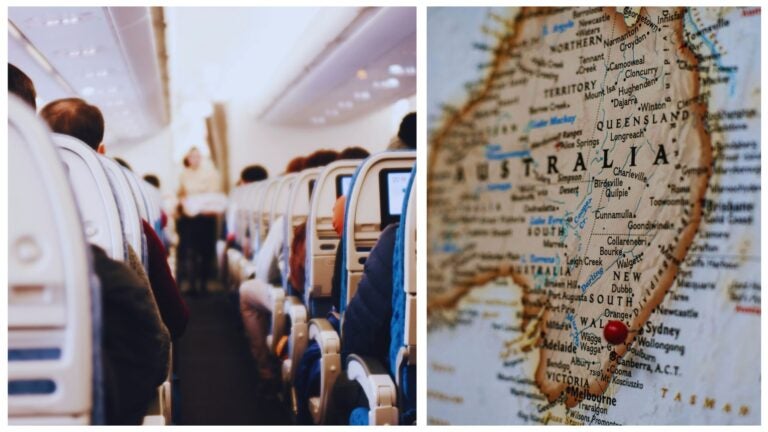What are the requirements to travel to Australia from the USA?
Here are all the requirements to travel to Australia from the USA. Learn more and successfully pass through immigration control!
If experiencing the Sydney Opera House, riding massive waves, exploring coral reefs, or any other adventure in Australia is on your bucket list, start by planning your trip at the airport. Have you already checked the requirements to travel to Australia from the USA?
According to the U.S. Embassy in Australia, immigration checks are very thorough and strict when it comes to visitor eligibility. If your entry is denied, the American diplomatic mission in the country cannot intervene on your behalf. Keep in mind that if you don’t meet all the requirements, your next flight will be back to the U.S. Fortunately, Holafly is here to help you make sure nothing slips through the cracks. Check out this post for a full rundown of the documents you need, the immigration process, and practical tips for your trip to Australia.
First, some initial advice for traveling to Australia
Being offline while traveling feels like showing up in a new place completely unprepared. You feel lost, disconnected, and a little exposed. That is why having internet in a new city is a game changer. It helps you find places to eat, get a taxi, or stay in touch. Tip number one is to get a Holafly data plan. They offer 25 GB or unlimited high-speed data, not just in Australia but in 170 countries around the world. Check out the details below and make sure you are connected before you travel.
Important: If you are a frequent traveler and want to stay connected without worrying about expensive roaming or looking for a new SIM at every destination, Holafly’s subscription plans are for you. With a single eSIM, enjoy internet in more than 170 countries for a fixed price and no surprises on your bill. Travel without limits and connect easily and securely! 🚀🌍

At Holafly, we definitely want to reduce pre- and post-trip stress. Now, here are the requirements for traveling to Australia from the USA.
1. U.S. passport
First on the list of must-haves is your passport. Your U.S. passport needs to be valid for at least six months and have blank pages for entry stamps into Australia. If you plan to continue on to another country after Australia, make sure it also meets the passport requirements for your next destination.
Keep your passport in great shape if you want to avoid any trouble at immigration. If it’s a biometric one, you can breeze through the electronic gates at the airport and skip the usual chat with the officer.
2. Visas for traveling to Australia from the United States
No matter the reason for your trip, U.S. citizens need a visa to enter Australia legally. Below, we’ll go over some of the most common types. You can find the full list on the official website of Australia’s Department of Home Affairs.
Tourists
- Electronic Travel Authorization (ETA): This visa is valid for 12 months and allows multiple entries, with each stay lasting up to three months. It’s meant for vacations or visiting family. You can also take short courses of up to three months, but it doesn’t allow you to work for local companies or offer services. The cost is $12.
- Working Holiday Visa (Subclass 417 or 462): Designed for travelers between 18 and 30 who want to work and explore Australia, this visa is valid for one year. You’ll need to show proof of sufficient funds (at least $3,100).
Work
There are more than 20 different work visa options for traveling to Australia, each designed for specific situations and with its own set of requirements. We recommend visiting the official website of Australia’s Department of Home Affairs to find the one that best fits your work and travel plans. Some of the main options include:
- Temporary Skill Shortage Visa (subclass 482): Valid for up to four years, this visa is for skilled professionals who have a job offer in an in-demand field.
- Skilled Independent Visa (Subclass 189): This visa doesn’t require a job offer. Instead, it’s based on a points system that evaluates your experience in high-demand fields in Australia, along with your English skills and age.
Students
If your goal is to take a course or pursue a degree at an Australian institution, there are several visa options available. The most common is the Student Visa (Subclass 500), which allows you to stay for up to five years, depending on the length of your enrollment. To explore your options in more detail, check out our article on visas for studying in Australia.

3. Health insurance
If you are traveling to Australia from the U.S., having health insurance is a must, especially for work or student visas. It also comes in handy for any required medical checks to show you are not a public health risk. Even for tourism or business trips, insurance is a smart idea since unexpected illnesses or injuries can happen. Medical care in Australia can be expensive, with doctor visits ranging from $60 to $200 and hospital stays adding $600 to $2,000 per day.
4. Proof of financial solvency
This requirement for traveling to Australia from the U.S. comes into play even before you reach immigration at the airport. It is a condition for applications such as the Visitor Visa (Subclass 600) and the Working Holiday Visa, which require a minimum of $3,100 to cover your stay. Airport authorities may check this information, so have bank statements or other proof of financial stability ready.

5. Passing immigration control
To avoid delays and hold-ups at immigration, keep all your travel documents close but safely stored. When it’s your turn, be polite, answer all questions, and follow the instructions from immigration officers calmly and in order. If everything is in order, you’ll get your entry stamp and a warm welcome to Australia!
U.S. citizens over 16 with an electronic passport can skip the conversation with an immigration officer and complete border checks using the SmartGates kiosks available at major airports in Australia.
How does it work?
- You scan your electronic passport at the SmartGate machine.
- The system verifies your identity through facial recognition.
- If everything is in order, your immigration control process will be successfully completed.
- In the event of a system problem and the system does not recognize your data digitally, you will go through the traditional immigration process.
Which airports in Australia have SmartGates?
- Adelaide
- Brisbane
- Cairns
- Darwin
- Gold Coast
- Melbourne
- Perth
- Sydney

Other tips for traveling to Australia
- Purchase travel insurance: If you’re visiting as a tourist and don’t want to spend on a full insurance plan, a basic travel policy can still protect you during your trip. It usually covers things like lost luggage, flight delays or cancellations, medical emergencies, and repatriation.
- Driver’s license: In cities like Sydney or Melbourne, public transportation is reliable, but in more remote areas, renting a car is the best option. Your U.S. driver’s license is valid for only three months, and keep in mind that Australians drive on the left. For longer stays, you’ll need to get an Australian license.
- Bring a power adapter: Australia uses different power outlets, so charging your phone or other devices could be tricky. Make sure to bring an adapter before you travel.
- Use sunscreen: In Australia, people are more exposed to the sun due to the hole in the ozone layer.
- Pay attention to warning signs: In some areas, you may see signs warning about spiders, jellyfish, or venomous snakes. Pay attention to them and stay cautious.
Frequently asked questions about requirements for traveling to Australia from the USA
Yes, U.S. citizens need an ETA (Electronic Travel Authority) before traveling, or another type of visa for tourism, study, or work, as a requirement to enter Australia.
The ETA allows multiple entries over a 12-month period. The longest you can stay in Australia at one time is 90 days. After that, you must leave the country and re-enter if you want to continue following the immigration rules.
If you’re traveling from the U.S. on an ETA, health insurance isn’t mandatory, but it is recommended for your safety. For other types of tourist visas, like the Working Holiday Visa that allows you to work and travel, having insurance is required to get your application approved.
Yes, as long as it is in English, your license is valid for three months. If it’s in another language, you’ll need an International Driving Permit (IDP). Keep in mind that in Australia, people drive on the left.
Due to strict biosecurity measures, you cannot bring fruit, seeds, or animal products without declaring them to customs.
No, U.S. citizens and other foreigners traveling on an electronic travel pass are not allowed to work in Australia. If you want to work, you need to apply for the appropriate visa.
Summer, from December to February, is perfect for enjoying Australia’s famous beaches and outdoor activities, while winter, from June to August, is the best time to explore the country’s semi-arid regions.





 Language
Language 


















 No results found
No results found



